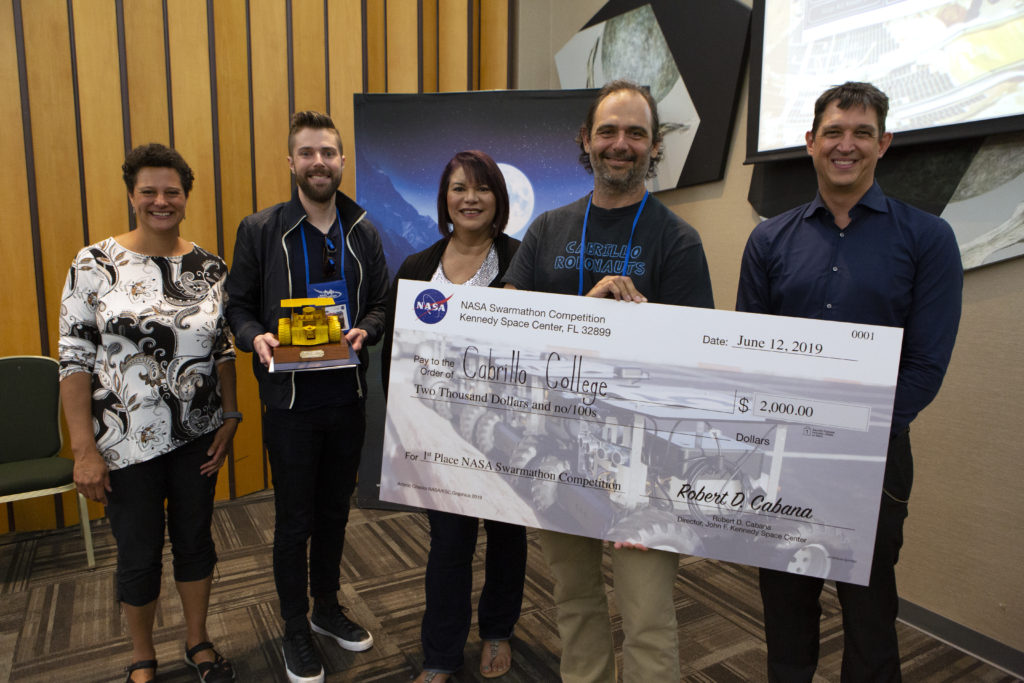
The Swarmie Robot

The NASA Swarmathon Challenge
Swarmies are small robotic vehicles equipped with sensors, a webcam, GPS system, and Wi-Fi antenna. They operate autonomously and can be programmed to communicate and interact as a collective swarm. Swarmies present the potential to dramatically improve the ability for robots to efficiently locate, identify and collect resources over large and previously unexplored territory. In addition to being the most effective way to scour large territories for resources, robotic swarms are more robust, flexible, and scalable than monolithic robots operating alone.
The UNM-NASA Swarmathon was a competition that ran between 2015 and 2019 designed to engage students in developing algorithms for robotic resource collection to support human space exploration.[1],[2]. ”Swarmathon will harness student creativity to solve difficult and complex problems. This is an incredible opportunity for students to develop technologies to explore our world and beyond."[3] The Swarmathon was a cooperative agreement between the NASA Minority University Research and Education Program (MUREP) and the University of New Mexico Department of Computer Science in partnership with the NASA John F. Kennedy Space Center Swamp Works. The competition ran from 2015 to 2019. The Swarmathon targeted colleges and universities serving minority and historically underrepresented student populations across the US. To reduce the traditional barriers to entry in robotics, participating institutions were loaned robots and provided with technical support. The competition emphasised implementation using the Robot Operating System (ROS) so that the skills developed would translate immediately into industry and research positions. Swarmathon was recognised for reaching underrepresented students, "Airbus, the Global Engineering Deans Council (GEDC) and The United Nations Educational, Scientific and Cultural Organization (UNESCO), today announced the three finalist projects for the 2018 Airbus GEDC Diversity Award."[4] The Swarmathon involved well over 1500 students from more than 40 colleges and universities [5]. College teams performed outreach to high schools in their area and mentored high school teams in a separate high-school competition. The high-school students implemented their resource collection algorithms in NetLogo.

Comptetition Results
The top three teams from the 4 years of the Swarmathon competition are listed below. The competition had a division for physical robots and for robots running in simulation for the first 3 years. The final year combined the simulation and physical competition into one. Cabrillo College won the final years competition[6]
Swarmathon I (2015-2016)
Physical Competition:
Fayetteville State University
Central New Mexico Community College
Southwestern Indian Polytechnic Institute
Simulation Competition:
Cabrillo College
Durham Technical Community College
Texas A&M International University
Swarmathon II (2016-2017)
Physical Competition:
Southwestern Indian Polytechnic Institute
University of Houston
California State University-Channel Islands
Simulation Competition:
Montgomery College
University of Hawai‘i at Hilo
Inter American University of Puerto Rico
Swarmathon III (2017-2018)
Physical Competition:
Durham Technical Community College
Southwestern Indian Polytechnic Institute
Jackson State University
Simulation Competition:
City College of New York
El Paso Community College
University of Maryland
Swarmathon VI (2018-2019)
Cabrillo College
University of Puerto Rico at Arecibo
University of Houston–Clear Lake & San Jacinto College
Competition Results